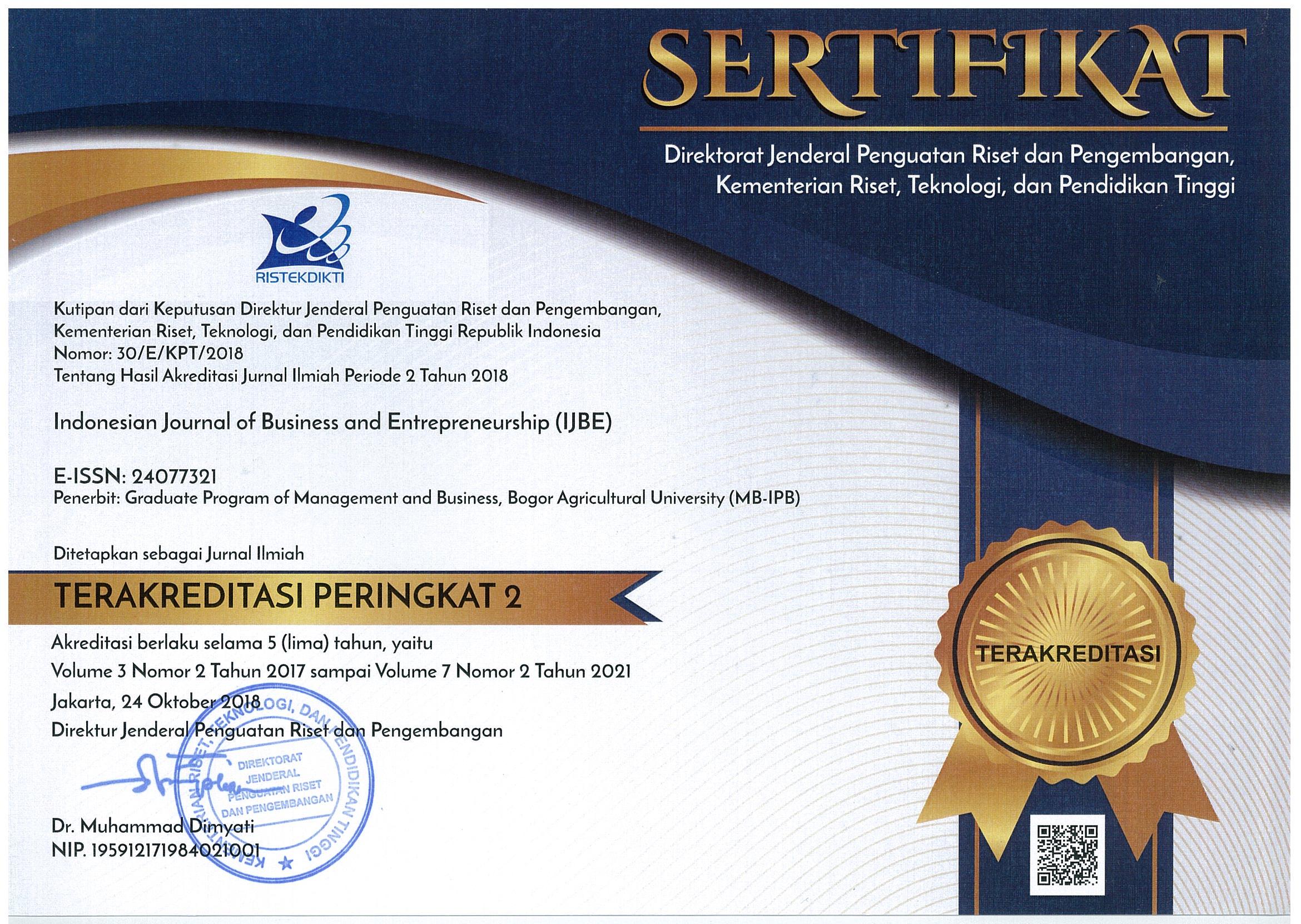The Effect of Social Capital on the Innovation Performance of the Small-Middle Scaled Enterprises of Agribusiness in Bogor Regency
Abstract
The aim of the research was to analyze the relationship between the social capital and innovation performance of agribusiness in Regency Bogor. The sample of the research was set as purposive sampling. There were 38 respondents involved from the nine districts. By the criteria, the entrepreneurs are also the owners of the agribusiness MSMEs and have been running their company for two years minimally. The data were analyzed by Sequal Equation Modeling Partial Least Square (SEM-PLS) method with SMART PLS 3.2.4. Based on the results, the majority of agribusiness MSMEs in Bogor Regency produce local and traditional products and have 1 to 5 employees. They earn money less than 100 million rupiahs annually, and most of them are categorized as the entrepreneurs of the micro and small enterprises. Social norm gives influence on innovation performance significantly, and it is reflected by providing aid to each other, having access to aids and willingness to share any information. The entrepreneurs of the agribusiness MSMEs possessing social norm will increase their innovation performance. Willingness to provide aid is the indicator to contribute significantly to social norm. Social network also gives effects significantly on innovation performance. Social network is reflected by network size, multiplexity and network constraints. The larger the network size, the wider important information related to the enterprises; therefore, it will increase opportunity to innovate. The height of multiplexity and network constraints will reduce the chance to innovate. Multiplexity is the highest indicator contributing to social network whereas trust variable does not give contribution significantly to innovation performance of the agribusiness MSMEs.
Keywords: MSMEs, social capital, agribusiness, innovation performance
Downloads
References
Adler PS, Kwon SW. 2002. Social capital: prospect for a new concept. The Academy of Management Review 27: 17–40.
Antoldi F. 2011. Strategic Networks, Trust and the Competitive Advantage of SMEs. XIV: 23–42.
[BPS] Badan Pusat Statistik. 2016. Buku Statistik Indonesia. Jakarta: BPS Jakarta.
Burt RS. 1992. Structural holes: The social structure of competition. Cambridge, MA: Harvard University Press.
Brata AG. 2004. Nilai Ekonomis Modal Sosial pada Sektor Informal Perkotaan. Jakarta: Lembaga Penelitian Universitas Atma Jaya.
Fujiwara T, Kawachi I. 2008. A prospective study of individual-level social capital and major depression in the United States. Journal of Epidemiology & Community Health 62: 627–633. https://doi.org/10.1136/jech.2007.064261.
Gay LR, Diehl PJ. 1992. Research Methods for Bussiness and Management. New York: Macmillan Publishing Company.
Granovetter MS. 1973. The strength of weak ties. American Journal of Sociology 78: 1360–1380. https://doi.org/10.1086/225469.
Granovetter M. 1985. Economic action and social structure: the problem of embeddedness. American Journal of Sociology 91(3): 481–510. https://doi.org/10.1086/228311.
Humaira R. 2011. Peranan modal sosial dalam pengembangan nilai kewirausahaan (Kasus Pedagang Kecil dan Anggota Kelompok Tani di Desa Cikarawang Kecamatan Dramaga Kabupaten Bogor) [skripsi]. Bogor: IPB.
Latan H, Ghozali I. 2015. Partial Least Square Konsep, Teknik dan Aplikasi Menggunakan Program SmartPLS 3.0. Semarang: Penerbit Universitas Diponegoro.
Lyer S, Kitson M, Toh B. 2005. Social Capital, Economic Growth, and Regional Development. Regional Studies 39(8):1015–1040. https://doi.org/10.1080/00343400500327943.
Marks MA, Mathieu MJ, Zaccaro SJ. 2001. A temporally based framework and taxonomy of team processes. Academy of Management Review 26: 356–376.
Nahapiet J, Ghoshal S. 1998. Social capital, intellectual capital, and the organizational advantage. Academy of Management Review 23: 242–66.
Nurhayati P, Sarianti T, Daryanto HK, Muflikh YN. 2011. Analisis Pengaruh Karakteristik Kewirausahaan Terhadap Kinerja Wirausaha Pada Unit Usaha Kecil Menengah (UKM) Agroindustri Di Kabupaten Bogor. In: Prosiding Seminar Penelitian Unggulan Departemen Agribisnis 2011.
Podolny JM, Baron JN. 1997. Resources and relationships: social networks and mobility in the workplace. American Sociological Review 62(5): 673–693. https://doi.org/10.2307/2657354.
Putnam R. 1995. The Prosperous Community-Social Capital and Public Life. America.
Qinxuan Gu, GregG W, Lihong W. 2013. Social capital and innovation in R&D teams: the mediating roles of psychological safety and learning from mistakes. R&D Management 43(2): 89–102. https://doi.org/10.1111/radm.12002.
Rickards T, Chen MH, Moger S. 2001, Development of a self-report instrument for exploring team factor, leadership and performance relationship. British Journal of Management 12(4): 243–250. https://doi.org/10.1111/1467-8551.00197.
Rooks G, Szirmai A dan Sserwanga A. 2009. Social Capital and Innovative Performance in Developing Countries The Case of Ugandan Entrepreneurs. Paper 7th Globelic conference on Inclusive Growth, Innovation and Technological Change Dakar, Senegal,Vol 22: 1-27, October 2009.
Rosenquist JN, Fowler JH, Christakis NA. 2011. Social network determinants of depression. Molecular Psychiatry 16: 273–281. https://doi.org/10.1038/mp.2010.13.
Salaff, Greeve. 2009. Social capital and entrepreneurship. Entrepreneurship, Theory & Practice 28(1): 1–22.
Sitepu SNB. 2017. How innovation encourages self eficasy to support business start up success?.Indonesian Journal of Business and Entrepreneurship 3(2).
Sudrajat D. 2013. Kapabilitas dinamik, kinerja inovasi dan kinerja perusahaan jasa logistik di Indonesia. Jurnal Bina Nusantara 5(1):798-811.
Vathsala W, Purnima W. 2011. Benefits gained from dimensions of social capital: a study of software developers in Sri Lanka. Information Technology & People 24(4): 393–413. https://doi.org/10.1108/09593841111182287.
Vipriyanti NU. 2011. Modal Sosial dan Pembangunan Wilayah. Malang: UBPress.
Vishal K. Gupta RH, Ali AY. 2011. Social capital, collective transformational leadership and performance: a resource-based view of self-managed teams. Journal of Mangerial XXIII(1): 31–45.
Yan Y, Jin-Xing H, Xiao YD, Mohamed K. 2013. A multilevel model for effects of social capital and knowledge sharing in knowledge-intensive work teams. International Journal of Information Management 33: 780–790. https://doi.org/10.1016/j.ijinfomgt.2013.05.005.
Yu C, Junshu D. 2013. A literature review of the effects of social capital-from the personal network perspective. International Journal of Business and Social Science 4(12):251–257.







